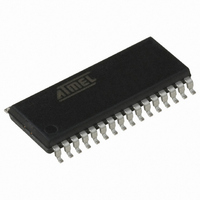AT90PWM3-16SQ Atmel, AT90PWM3-16SQ Datasheet - Page 34

AT90PWM3-16SQ
Manufacturer Part Number
AT90PWM3-16SQ
Description
IC AVR MCU FLASH 8K 32SOIC
Manufacturer
Atmel
Series
AVR® 90PWM Lightingr
Datasheet
1.AT90PWM3B-16SU.pdf
(361 pages)
Specifications of AT90PWM3-16SQ
Core Processor
AVR
Core Size
8-Bit
Speed
16MHz
Connectivity
SPI, UART/USART
Peripherals
Brown-out Detect/Reset, POR, PWM, WDT
Number Of I /o
27
Program Memory Size
8KB (8K x 8)
Program Memory Type
FLASH
Eeprom Size
512 x 8
Ram Size
512 x 8
Voltage - Supply (vcc/vdd)
2.7 V ~ 5.5 V
Data Converters
A/D 11x10b; D/A 1x10b
Oscillator Type
Internal
Operating Temperature
-40°C ~ 105°C
Package / Case
32-SOIC (7.5mm Width)
Processor Series
AT90PWMx
Core
AVR8
Data Bus Width
8 bit
Data Ram Size
512 B
Interface Type
SPI, USART
Maximum Clock Frequency
16 MHz
Number Of Programmable I/os
27
Number Of Timers
2
Operating Supply Voltage
2.7 V to 5.5 V
Maximum Operating Temperature
+ 105 C
Mounting Style
SMD/SMT
3rd Party Development Tools
EWAVR, EWAVR-BL
Development Tools By Supplier
ATAVRDRAGON, ATSTK500, ATSTK600, ATAVRISP2, ATAVRONEKIT, ATAVRFBKIT, ATAVRISP2
Minimum Operating Temperature
- 40 C
On-chip Adc
10 bit, 11 Channel
On-chip Dac
10 bit, 1 Channel
For Use With
ATSTK600-SOIC - STK600 SOCKET/ADAPTER FOR SOICATAVRMC200 - KIT EVAL FOR AT90PWM3 ASYNCATAVRFBKIT - KIT DEMO BALLAST FOR AT90PWM2ATSTK520 - ADAPTER KIT FOR 90PWM
Lead Free Status / RoHS Status
Lead free / RoHS Compliant
- Current page: 34 of 361
- Download datasheet (7Mb)
7.6
7.6.1
34
PLL
AT90PWM2/3/2B/3B
Internal PLL for PSC
Note that this oscillator is used to time EEPROM and Flash write accesses, and these write
times will be affected accordingly. If the EEPROM or Flash are written, do not calibrate to more
than 8.8 MHz. Otherwise, the EEPROM or Flash write may fail.
The CAL7 bit determines the range of operation for the oscillator. Setting this bit to 0 gives the
lowest frequency range, setting this bit to 1 gives the highest frequency range. The two fre-
quency ranges are overlapping, in other words a setting of OSCCAL = 0x7F gives a higher
frequency than OSCCAL = 0x80.
The CAL6..0 bits are used to tune the frequency within the selected range. A setting of 0x00
gives the lowest frequency in that range, and a setting of 0x7F gives the highest frequency in the
range. Incrementing CAL6..0 by 1 will give a frequency increment of less than 2% in the fre-
quency range 7.3 - 8.1 MHz.
To generate high frequency and accurate PWM waveforms, the ‘PSC’s need high frequency
clock input. This clock is generated by a PLL. To keep all PWM accuracy, the frequency factor of
PLL must be configurable by software. With a system clock of 8 MHz, the PLL output is 32Mhz
or 64Mhz.
The internal PLL in AT90PWM2/2B/3/3B generates a clock frequency that is 64x multiplied from
nominally 1 MHz input. The source of the 1 MHz PLL input clock is the output of the internal RC
Oscillator which is divided down to 1 MHz. See the
The PLL is locked on the RC Oscillator and adjusting the RC Oscillator via OSCCAL Register
will adjust the fast peripheral clock at the same time. However, even if the possibly divided RC
Oscillator is taken to a higher frequency than 1 MHz, the fast peripheral clock frequency satu-
rates at 70 MHz (worst case) and remains oscillating at the maximum frequency. It should be
noted that the PLL in this case is not locked any more with the RC Oscillator clock.
Therefore it is recommended not to take the OSCCAL adjustments to a higher frequency than 1
MHz in order to keep the PLL in the correct operating range. The internal PLL is enabled only
when the PLLE bit in the register PLLCSR is set. The bit PLOCK from the register PLLCSR is
set when PLL is locked.
Both internal 1 MHz RC Oscillator and PLL are switched off in Power-down and Standby sleep
modes
.
Table 7-9.
RC Osc
CKSEL
0011
3..0
SUT1..0
Start-up Times when the PLL is selected as system clock
00
01
10
11
Start-up Time from Power-down
and Power-save
16K CK
1K CK
1K CK
1K CK
Figure 7-4 on page
Additional Delay from Reset
35.
14CK + 64 ms
14CK + 4 ms
(V
CC
14CK
14CK
= 5.0V)
4317J–AVR–08/10
Related parts for AT90PWM3-16SQ
Image
Part Number
Description
Manufacturer
Datasheet
Request
R

Part Number:
Description:
IC AVR MCU FLASH 8K 32QFN
Manufacturer:
Atmel
Datasheet:

Part Number:
Description:
MCU AVR 8K FLASH 16MHZ 32-QFN
Manufacturer:
Atmel
Datasheet:

Part Number:
Description:
DEV KIT FOR AVR/AVR32
Manufacturer:
Atmel
Datasheet:

Part Number:
Description:
INTERVAL AND WIPE/WASH WIPER CONTROL IC WITH DELAY
Manufacturer:
ATMEL Corporation
Datasheet:

Part Number:
Description:
Low-Voltage Voice-Switched IC for Hands-Free Operation
Manufacturer:
ATMEL Corporation
Datasheet:

Part Number:
Description:
MONOLITHIC INTEGRATED FEATUREPHONE CIRCUIT
Manufacturer:
ATMEL Corporation
Datasheet:

Part Number:
Description:
AM-FM Receiver IC U4255BM-M
Manufacturer:
ATMEL Corporation
Datasheet:

Part Number:
Description:
Monolithic Integrated Feature Phone Circuit
Manufacturer:
ATMEL Corporation
Datasheet:

Part Number:
Description:
Multistandard Video-IF and Quasi Parallel Sound Processing
Manufacturer:
ATMEL Corporation
Datasheet:

Part Number:
Description:
High-performance EE PLD
Manufacturer:
ATMEL Corporation
Datasheet:

Part Number:
Description:
8-bit Flash Microcontroller
Manufacturer:
ATMEL Corporation
Datasheet:

Part Number:
Description:
2-Wire Serial EEPROM
Manufacturer:
ATMEL Corporation
Datasheet:










